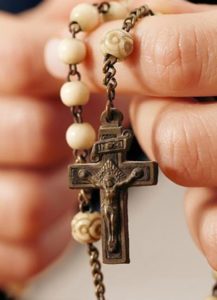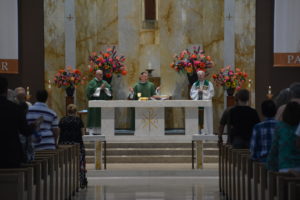Strong Prayer Life Influences Choice to Become Nun, Brother, Suggests CARA Study
WASHINGTON—Nearly all of the
religious men and women who professed perpetual vows in 2016 had a strong
prayer life prior to entering their religious institute, according to a survey
on men and women religious conducted by the Center for Applied Research in the
Apostolate (CARA) at Georgetown University. The survey results were released
February 2, to coincide with the annual celebration of World Day for
Consecrated Life.
The U.S. Conference of Catholic
Bishops’ (USCCB) Secretariat of Clergy, Consecrated Life and Vocations (CCLV)
commissioned the Center for Applied Research in the Apostolate (CARA) to
conduct the annual survey of the religious profession class of 2016.
The large percentage of newly professed religious who
responded to the survey is the result of the generous cooperation of religious
institutes across the United States. “The participation in the survey by
religious communities is remarkable,” said Cardinal Joseph Tobin, C.Ss.R., of
Newark, chair of the USCCB Committee on Clergy, Consecrated Life, and
Vocations. “The Church is grateful for those women and men who have given their
lives to Jesus Christ through the profession of final vows. Their participation
in this survey and the information gained from it, helps the Church’s work to
encourage all to listen for God’s call.”
The survey polled women and men
religious who professed perpetual vows in 2016 in a religious congregation,
province, or monastery based in the U.S. CARA received a response from 610 of
759 major superiors, for an overall response rate of 80 percent among religious
institutes.
Of these 216 identified women and
men religious, a total of 81 sisters and nuns and 96 brothers and priests
responded to the survey. These 96 men may include some brothers who intend to
pursue studies leading to priestly ordination. This represents a response rate
of 82 percent of the 216 potential members of the Profession Class of 2016 that
were reported to CARA by major superiors.
Some of the major findings of the
report are:
·
Nearly nine in ten or 86 percent of
responding religious regularly participated in some type of private prayer
activity before they entered their religious institute. About two-thirds
participated in Eucharistic Adoration, prayed the rosary, or attended retreats
before entering. Nearly six in ten participated in spiritual direction before
entering.
·
Most
religious did not report that educational debt delayed their application for
entrance to their institute. Among the 4 percent who did report having
educational debt, however, they averaged about 4 years of delay while they paid
down an average of $29,100 in educational debt.
·
The
average age of responding religious is 39.
Half of the responding religious are age 36 or younger. The youngest is 26 and the oldest is 86.
·
Two-thirds
of responding religious (66 percent) identify as white, more than one in six
(16 percent) identifies as Asian, and more than one in ten (11 percent)
identifies as Hispanic.
·
Most
responding religious (67 percent) were born in the U.S. Of those born outside the United States, the
most common country of origin is Vietnam.
·
Among
those identifying as Hispanic/Latino six in ten (58 percent) are U.S. born.
Those identifying as Asian/Pacific Islander/Native Hawaiian (96 percent) are
predominantly foreign born. Nearly all
identifying as Caucasian/white (91 percent) are U.S. born.
·
Almost
half of responding religious (46 percent) attended a Catholic elementary
school, which is about the same as that for all Catholic adults in the United
States (39 percent). These respondents are more likely than other U.S.
Catholics to have attended a Catholic high school (38 percent of respondents,
compared to 19 percent of U.S. adult Catholics) and much more likely to have
attended a Catholic college (37 percent of responding religious, compared to
just 10 percent of U.S. adult Catholics).
Responding women religious are less likely than brothers to have
attended a Catholic college (31 percent for women compared to 42 percent for
men).
·
On
average, responding religious report that they were 19 years old when they
first considered a vocation to religious life, but half were 18 or younger when
they first did so.
·
One-half
say that a parish priest (53 percent) encouraged their vocation.
·
Four
in ten report being encouraged to consider a vocation by a religious sister or
brother. Women religious were more
likely than men religious to do so.
·
Over
four in ten report that they were encouraged to consider a vocation by their
friends.
The
survey and more information on the Secretariat of Clergy, Consecrated Life and
Vocations can be found at www.usccb.org/consecratedlife.
—
Keywords:
Center for Applied Research in the Apostolate, CARA, Class of 2016, religious life,
CCLV, Clergy, Consecrated Life and Vocations, USCCB, CMSM, LCWR, CMSWR, U.S.
Conference of Catholic Bishops, World Day for Consecrated Life
# # #
MEDIA CONTACT:
Norma Montenegro Flynn
O: 202-541-3202
Categories
From the Desk of Fr. JohnSs. Peter & Paul NewsU.S. Conf. of Catholic BishopsVatican Information ServiceWhat's HappeningUpcoming Events



